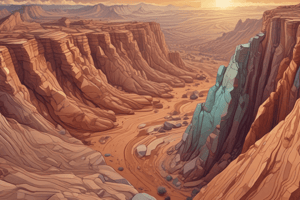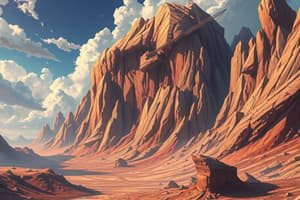Podcast
Questions and Answers
What is the primary focus of the rock cycle?
What is the primary focus of the rock cycle?
- The changing climates affecting rock formations
- The formation of different minerals within rocks
- The influence of human activity on rock structures
- The continuous transformation of rocks from one type to another (correct)
Which of the following accurately describes the types of rocks involved in the rock cycle?
Which of the following accurately describes the types of rocks involved in the rock cycle?
- Sedimentary, organic, and crystalline
- Igneous, sedimentary, and volcanic
- Sedimentary, igneous, and metamorphic (correct)
- Metamorphic, volcanic, and chemical
How does understanding the rock cycle contribute to our knowledge of the Earth?
How does understanding the rock cycle contribute to our knowledge of the Earth?
- It helps comprehend the composition of the atmosphere
- It provides insight into Earth's history and crust evolution (correct)
- It reveals how rocks can be artificially synthesized
- It determines the distribution of minerals across the globe
What does the term 'continuous change' in the rock cycle imply?
What does the term 'continuous change' in the rock cycle imply?
Which statement accurately reflects the relationships between the rock types in the rock cycle?
Which statement accurately reflects the relationships between the rock types in the rock cycle?
What process primarily determines the texture and mineral composition of igneous rocks?
What process primarily determines the texture and mineral composition of igneous rocks?
Which characteristic is indicative of sedimentary rocks?
Which characteristic is indicative of sedimentary rocks?
What is the primary factor that leads to the formation of metamorphic rocks?
What is the primary factor that leads to the formation of metamorphic rocks?
Which of the following is an example of an igneous rock?
Which of the following is an example of an igneous rock?
Which process does NOT contribute to the formation of sedimentary rocks?
Which process does NOT contribute to the formation of sedimentary rocks?
Flashcards are hidden until you start studying
Study Notes
Rock Cycle Overview
- The Rock Cycle is a natural, continuous process of change occurring both on Earth's surface and underground.
- Represents an ongoing journey that transforms rocks through various stages and processes.
- Understanding the rock cycle is vital for comprehending Earth's geological history and crust evolution.
Types of Rocks
- There are three primary types of rocks involved in the rock cycle:
- Igneous Rocks: Formed from cooled and solidified magma or lava.
- Sedimentary Rocks: Formed from the accumulation, compaction, and cementation of mineral and organic particles.
- Metamorphic Rocks: Created through the alteration of existing rocks under heat, pressure, and chemically active fluids.
Transformative Processes
- Each rock type can transform into another through various processes such as:
- Weathering and Erosion: Break down and transport minerals to form sedimentary rocks.
- Melting: Transforms solid rock into magma, leading to the formation of igneous rocks upon cooling.
- Heat and Pressure: Convert sedimentary or igneous rocks into metamorphic rocks.
Importance of the Rock Cycle
- The rock cycle provides insight into Earth’s dynamic processes and historical geology.
- It illustrates how the planet continuously recycles materials, contributing to the shaping of landscapes over geological time.
Igneous Rocks
- Formed from the solidification of molten rock.
- Originates from volcanic eruptions or magma from deep within the Earth's crust.
- Cooling rate significantly affects the rock's texture and mineral composition.
- Notable examples include granite, basalt, and obsidian.
Sedimentary Rocks
- Created by the accumulation of sediment at the bottoms of lakes, rivers, and oceans.
- Over time, sediments are compacted and cemented, forming distinct layers known as strata.
- Common types of sedimentary rocks include sandstone, limestone, and shale.
Metamorphic Rocks
- Result from the transformation of existing rocks due to heat, pressure, or chemical reactions.
- This process alters the rock's texture, mineral composition, and physical properties.
- Examples of metamorphic rocks are marble, slate, and gneiss.
Studying That Suits You
Use AI to generate personalized quizzes and flashcards to suit your learning preferences.




